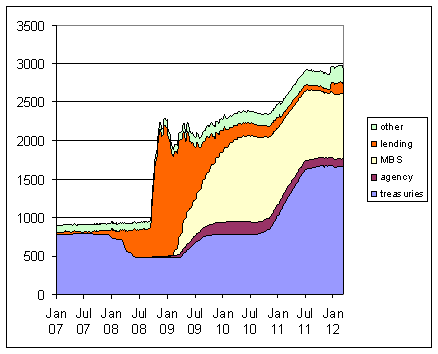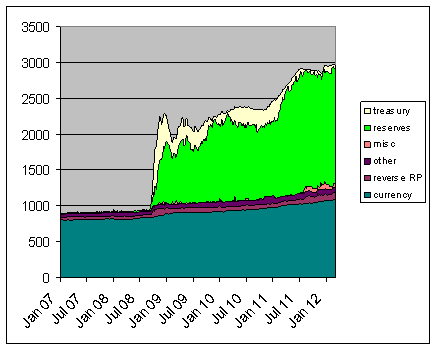Jon Hilsenrath of the Wall Street Journal reported last week that Federal Reserve officials are evaluating the possibility of a measure that the journal describes as “sterilized” quantitative easing. How would this work, and what would it be intended to accomplish?
From the Wall Street Journal:
Federal Reserve officials are considering a new type of bond-buying program designed to subdue worries about future inflation if they decide to take new steps to boost the economy in the months ahead.
Under the new approach, the Fed would print new money to buy long-term mortgage or Treasury bonds but effectively tie up that money by borrowing it back for short periods at low rates. The aim of such an approach would be to relieve anxieties that money printing could fuel inflation later, a fear widely expressed by critics of the Fed’s previous efforts to aid the recovery.
To understand what this means, let’s begin by looking at the consolidated assets of the Federal Reserve. Traditionally, the primary assets of the Fed were just Treasury securities, as seen in the blue area on the graph below. During the financial crisis in 2008, the Fed extended a series of emergency loans in the form of currency swaps, the Commercial Paper Funding Facility, the Term Auction Facility, and a host of other new lending program, as indicated by the orange region. As financial concerns eased, the Fed replaced these emergency loans with large holdings of mortgage-backed securities, maintaining its total assets at the new high levels. The Fed made a subsequent decision to expand its holdings of longer-term Treasury securities in November of 2010, in what came to be popularly referred to as a second phase of quantitative easing, or QE2.

Federal Reserve assets, in billions of dollars, seasonally unadjusted, from Jan 1, 2007 to March 7, 2012. Wednesday values, from Federal Reserve H41 release. Treasuries: U.S. Treasury securities held outright. agency: federal agency debt securities held outright; MBS: mortgage-backed securities held outright; other: sum of float, gold stock, special drawing rights certificate account, Treasury currency outstanding, and other Federal Reserve assets; lending: sum of central bank liquidity swaps, credit extended to American International Group, Maiden Lane holdings, preferred interest in AIA Aurora LLC and ALICO Holdings LLC; Money Market Investor Funding Facility, Term Asset-Backed Securities Loan Facility and TALF holdings, Asset-Backed Commercial Paper Money Market Mutual Fund Liquidity Facility; primary dealer and other broker-dealer credit; primary credit, secondary credit, and seasonal credit, Commercial Paper Funding Facility, term auction credit, and repurchase agreements.
Alternatively, one can look at the liabilities side of the Fed’s balance sheet, whose total value at each date is by the nature of double-entry accounting exactly equal to the value of the Fed’s assets. Traditionally, the Fed’s principle liability consisted of publicly circulating currency (dark green in the graph below). For this reason, the Fed’s purchases of Treasury securities are often popularly described as being paid for by “printing money”. However, very little of the Fed’s expanded operations since 2008 have been financed in this way. Instead, the main growth in the Fed’s liabilities has come in the form of reserves held by financial institutions in accounts with the Fed.

Federal Reserve liabilities, in billions of dollars, seasonally unadjusted, from Jan 1, 2007 to March 7, 2012. Wednesday values, from Federal Reserve H41 release. Treasury: sum of U.S. Treasury general and supplementary funding accounts; reserves: reserve balances with Federal Reserve Banks; misc: sum of Treasury cash holdings, foreign official accounts, required clearing balance, AIG dispositions, and float; other: other liabilities and capital; reverse RP: reverse repurchase agreements; Currency: currency in circulation.
Although currency may not be a true liability of the Fed in other than the double-entry accounting sense, reserves function much more like a conventional liability. For one thing, banks could at any time ask to convert these credits into green cash. If the present huge quantity of reserves were to end up as currency in circulation, the result would be highly inflationary, and the Fed would need to sell some of its assets or take some other action if it wanted to keep that from happening. Moreover, the Fed pays a 0.25% annual interest rate on reserves that banks keep on deposit with the Fed overnight. In effect, what the Fed has been doing since the fall of 2008 is borrowing by means of rolling over 1-day loans (that is, by means of interest-paying reserves) and using those funds to make emergency loans, buy MBS, or buy longer-term Treasury securities.
As these programs were implemented, there was considerable discussion of the Fed’s “exit strategy”, which referred in part to how it would prevent the reserves from ending up as circulating currency. Selling off its assets would be one option, but that might be more contractionary than the Fed would want to be in a weak recovery. Two years ago, Chairman Bernanke discussed the following alternatives:
One such tool is reverse repurchase agreements (reverse repos), a method that the Federal Reserve has used historically as a means of absorbing reserves from the banking system. In a reverse repo, the Federal Reserve sells a security to a counterparty with an agreement to repurchase the security at some date in the future. The counterparty’s payment to the Federal Reserve has the effect of draining an equal quantity of reserves from the banking system….
As a second means of draining reserves, the Federal Reserve is also developing plans to offer to depository institutions term deposits, which are roughly analogous to certificates of deposit that the institutions offer to their customers. The Federal Reserve would likely auction large blocks of such deposits, thus converting a portion of depository institutions’ reserve balances into deposits that could not be used to meet their very short-term liquidity needs and could not be counted as reserves.
As Bernanke noted, repos and reverse repos are quite traditional tools that the Fed has always used when it wanted to add or drain reserves on a temporary basis. Rolling over 28-day reverse repos, or auctioning 28-day term deposits to banks, would be one way to give the Fed a bit more management control over the liabilities it has created.
In effect, the Fed is currently funding its asset purchases by borrowing overnight, whereas under the new proposal it would do more of its borrowing with 28-day loans.
What difference does it make whether the loans are for 1 day or 28 days? Does it matter, as the Wall Street Journal suggests, for inflation expectations? I’m having a little trouble seeing why it should. Some analysts may worry about the mechanical and logistical challenges of managing the large volume of reserves as conditions change, and perhaps the proposal could relieve this concern somewhat. It may convince others that the Fed does not intend to allow its expanded balance sheet to end up in the form of circulating currency. The Fed might also worry that simply the announcement of expanding dependence on term deposits or reverse repos by itself might be mistakenly construed by the public as a signal that the tightening cycle has begun. A proposal of simultaneously announcing some new asset purchases funded by term borrowing could get the new borrowing regime up and running without sending the wrong signal.
More fundamentally, one might ask what good does it do for the Fed to borrow short and lend long? The net effect should be to put downward pressure on long-term rates in the hopes that this might boost home purchases, help households strengthen their balance sheets with refinancing, and encourage investment and net exports. A realistic assessment I think would say that the effects of borrowing short and lending long are likely to be pretty modest, particularly given that the U.S. Treasury has been issuing long-term debt faster than the Fed can buy it. My conclusion is that measures such as QE2, insofar as they had an effect, operated primarily as a tool the Fed can use to punctuate its declarations of near- and longer-term policy objectives.
And I’m inclined to form the same judgment about sterilized QE3.
Sterilized quantitative easing
- Bulenox: Get 45% to 91% OFF ... Use Discount Code: UNO
- Risk Our Money Not Yours | Get 50% to 90% OFF ... Use Discount Code: MMBVBKSM
Disclaimer: This page contains affiliate links. If you choose to make a purchase after clicking a link, we may receive a commission at no additional cost to you. Thank you for your support!



Leave a Reply